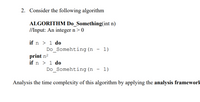
Database System Concepts
7th Edition
ISBN: 9780078022159
Author: Abraham Silberschatz Professor, Henry F. Korth, S. Sudarshan
Publisher: McGraw-Hill Education
expand_more
expand_more
format_list_bulleted
Question

Transcribed Image Text:2. Consider the following algorithm
ALGORITHM Do_Something(int n)
//Input: An integer n> 0
if n > 1 do
Do_Somehting (n - 1)
print n²
if n > 1 do
Do_Somehting (n
1)
Analysis the time complexity of this algorithm by applying the analysis framework
Expert Solution
This question has been solved!
Explore an expertly crafted, step-by-step solution for a thorough understanding of key concepts.
This is a popular solution
Trending nowThis is a popular solution!
Step by stepSolved in 2 steps

Knowledge Booster
Learn more about
Need a deep-dive on the concept behind this application? Look no further. Learn more about this topic, computer-science and related others by exploring similar questions and additional content below.Similar questions
- The following code is used to derive Fibonacci algorithm with this sequence: (0, 1, 1, 2, 3, 5, 8, 13, 21, …) where each number is “add” of two previous ones. int fib(int n){ if (n==0) return 0; else if (n == 1) return 1; else return fib(n−1) + fib(n−2); } Explain why the following RISC-V assembly code works, you need to explain all the details using the comments as hints? # IMPORTANT! Stack pointer must remain a multiple of 16!!!! 1. addi x10,x10,8 # fib(8), you can change it 2. fib: 3. beq x10, x0, done # If n==0, return 0 4. addi x5, x0, 1 5. beq x10, x5, done # If n==1, return 1 6. addi x2, x2, -16 # Allocate 2 words of stack space 7. sd x1, 0(x2) # Save the return address 8. sd x10, 8(x2) # Save the current n 9. addi x10, x10, -1 # x10 = n-1 10. jal x1, fib # fib(n-1) 11. ld x5, 8(x2) # Load old n from the stack 12. sd x10, 8(x2) # Push fib(n-1) onto the stack 13. addi x10, x5, -2 # x10 = n-2 14. jal x1, fib # Call fib(n-2) 15. ld x5, 8(x2) # x5 = fib(n-1) 16. add x10, x10, x5 #…arrow_forward1. Find the complexity of the algorithm as Big O notation: countValue(a, n, val) { } count=0 for i=1 to n { if (a[i]=val) count count + 1 QUESTIONS } return countarrow_forwardPythonarrow_forward
- Given below is a recursive algorithm to compute r". The input r can be any real number. The input n is assumed to be a non-negative integer. Exponent ( r, n) #Input: Real number r and a non-negative integer n. +Output: r If (n-0), return (1) p: Exponent ( ? ) Return ( rp) //The base case 7/The recursive call What missing input values should be used in the recursive call? O (r, n) O (r, n-1) O (r-1, n) O (r-1. n-1)arrow_forwardUsing recursion, write a function sum that takes a single argument n and computes the sum of all integers between 0 and n inclusive. Do not write this function using a while or for loop. Assume n is non-negative. def sum(n): """Using recursion, computes the sum of all integers between 1 and n, inclusive. Assume n is positive. >>> sum(1) 1 >>> sum(5) # 1 + 2 + 3+ 4+ 5 15 "*** YOUR CODE HERE ***"arrow_forwardThe following code is used to derive Fibonacci algorithm with this sequence: (0, 1, 1, 2, 3, 5, 8, 13, 21, …) where each number is “add” of two previous ones. int fib(int n){ if (n==0) return 0; else if (n == 1) return 1; else return fib(n−1) + fib(n−2); } Explain why the following RISC-V assembly code works, you need to explain all the details using the comments as hints? # IMPORTANT! Stack pointer must remain a multiple of 16!!!! addi x10,x10,8 # fib(8), you can change it fib: beq x10, x0, done # If n==0, return 0 addi x5, x0, 1 beq x10, x5, done # If n==1, return 1 addi x2, x2, -16 # Allocate 2 words of stack space sd x1, 0(x2) # Save the return address sd x10, 8(x2) # Save the current n addi x10, x10, -1 # x10 = n-1 jal x1, fib # fib(n-1) ld x5, 8(x2) # Load old n from the stack sd x10, 8(x2) # Push fib(n-1) onto the stack addi x10, x5, -2 # x10 = n-2 jal x1, fib # Call fib(n-2)…arrow_forward
arrow_back_ios
arrow_forward_ios
Recommended textbooks for you
 Database System ConceptsComputer ScienceISBN:9780078022159Author:Abraham Silberschatz Professor, Henry F. Korth, S. SudarshanPublisher:McGraw-Hill Education
Database System ConceptsComputer ScienceISBN:9780078022159Author:Abraham Silberschatz Professor, Henry F. Korth, S. SudarshanPublisher:McGraw-Hill Education Starting Out with Python (4th Edition)Computer ScienceISBN:9780134444321Author:Tony GaddisPublisher:PEARSON
Starting Out with Python (4th Edition)Computer ScienceISBN:9780134444321Author:Tony GaddisPublisher:PEARSON Digital Fundamentals (11th Edition)Computer ScienceISBN:9780132737968Author:Thomas L. FloydPublisher:PEARSON
Digital Fundamentals (11th Edition)Computer ScienceISBN:9780132737968Author:Thomas L. FloydPublisher:PEARSON C How to Program (8th Edition)Computer ScienceISBN:9780133976892Author:Paul J. Deitel, Harvey DeitelPublisher:PEARSON
C How to Program (8th Edition)Computer ScienceISBN:9780133976892Author:Paul J. Deitel, Harvey DeitelPublisher:PEARSON Database Systems: Design, Implementation, & Manag...Computer ScienceISBN:9781337627900Author:Carlos Coronel, Steven MorrisPublisher:Cengage Learning
Database Systems: Design, Implementation, & Manag...Computer ScienceISBN:9781337627900Author:Carlos Coronel, Steven MorrisPublisher:Cengage Learning Programmable Logic ControllersComputer ScienceISBN:9780073373843Author:Frank D. PetruzellaPublisher:McGraw-Hill Education
Programmable Logic ControllersComputer ScienceISBN:9780073373843Author:Frank D. PetruzellaPublisher:McGraw-Hill Education

Database System Concepts
Computer Science
ISBN:9780078022159
Author:Abraham Silberschatz Professor, Henry F. Korth, S. Sudarshan
Publisher:McGraw-Hill Education

Starting Out with Python (4th Edition)
Computer Science
ISBN:9780134444321
Author:Tony Gaddis
Publisher:PEARSON

Digital Fundamentals (11th Edition)
Computer Science
ISBN:9780132737968
Author:Thomas L. Floyd
Publisher:PEARSON

C How to Program (8th Edition)
Computer Science
ISBN:9780133976892
Author:Paul J. Deitel, Harvey Deitel
Publisher:PEARSON

Database Systems: Design, Implementation, & Manag...
Computer Science
ISBN:9781337627900
Author:Carlos Coronel, Steven Morris
Publisher:Cengage Learning

Programmable Logic Controllers
Computer Science
ISBN:9780073373843
Author:Frank D. Petruzella
Publisher:McGraw-Hill Education